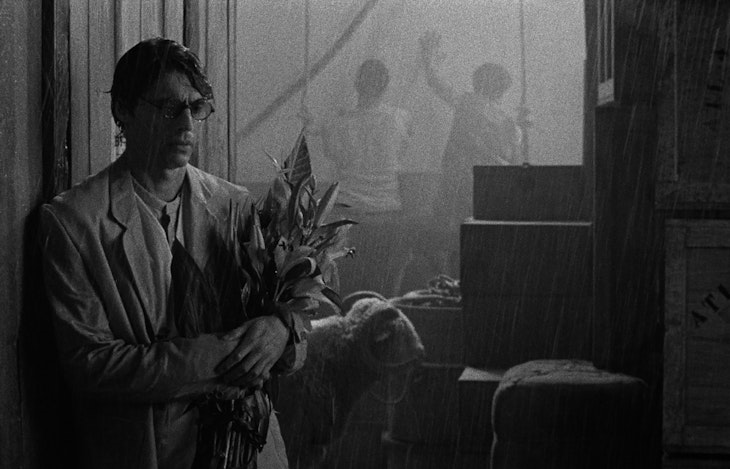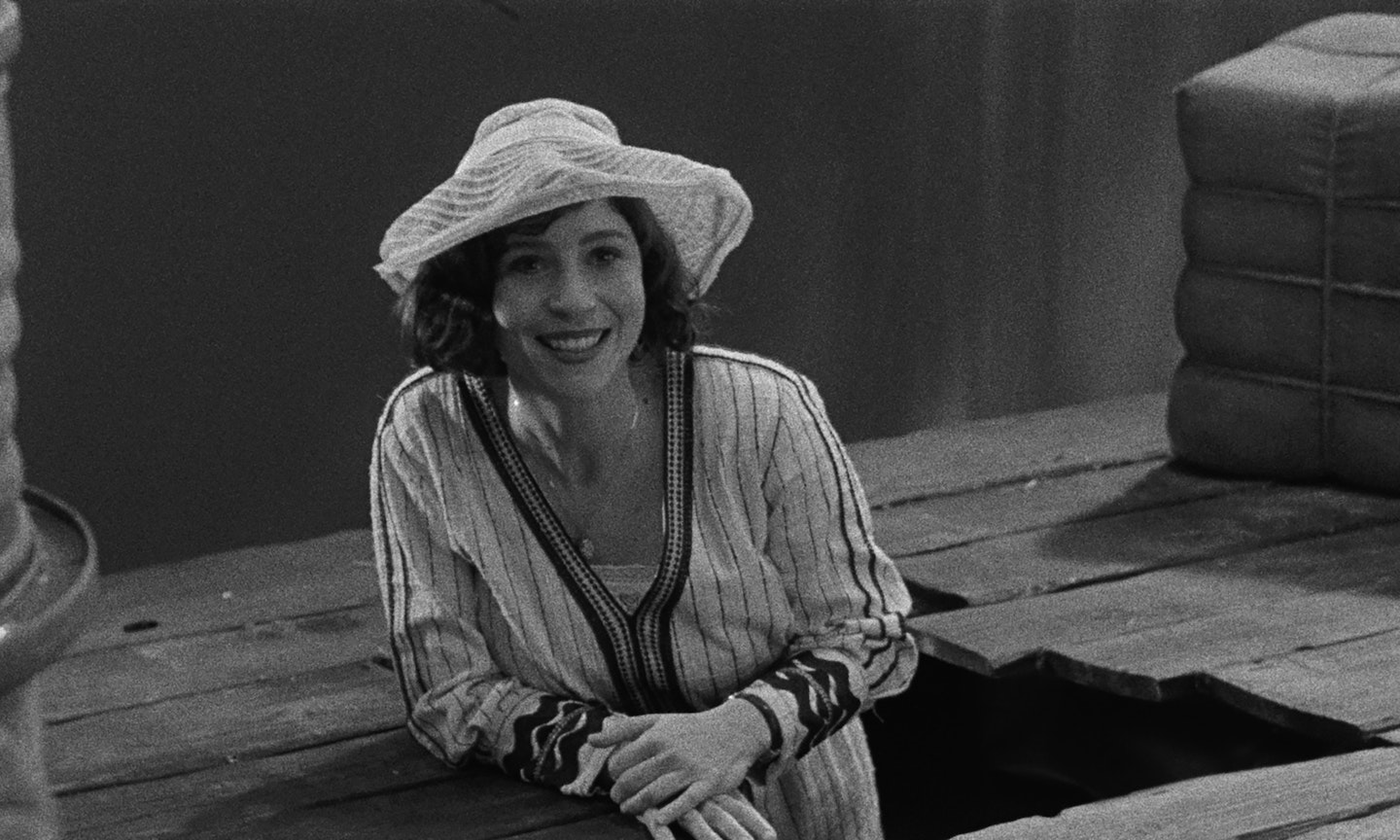Young Critics reviews: Grand Tour

Review by Theo Du
The (a)historical fiction of Grand Tour
A train crashes in the jungle. Just as steam bellows out of the upended carriage, Edward (Gonçalo Waddington), a white man in a thin linen suit, climbs out as well. Despite being in a dense rainforest, the sight of a westerner is not a spectacle to behold in this part of the world, in this part of history of Miguel Gomes’ Grand Tour. After he settles on his feet, he looks up towards the horizon, beyond the swaying trees, and says "what a beautiful morning." An artificial light shines on his bespectacled face, and a smile glimmers.
This white man, an English consul in Rangoon, is what the first half of the film follows around, on the run from his fiancée of seven years Molly (Crista Alfaiate) around various exotic Asian countries, from south to north. Or, more accurately, Edward seems to be pushed around by the force of the film. For although he is the protagonist of the first part of this epic, his passivity and introversion seem to be what the metaphysical forces of Grand Tour are preying on as an excuse to embark on the journey. The second half of the film flips the perspective and restarts from the beginning. It is now Molly that the camera follows, as she retraces her fiancé’s erratic, but ultimately grand, tour through Burma, Singapore, Thailand, Vietnam, Philippines, Japan, and China.
Part travelogue, part fantasia, Grand Tour flips the exotic travel film on its head. Effectively, the film points to the constructed nature of history, and departs from there. Inspired by the 1930 book The Gentleman in the Parlour by English author W. Somerset Maugham, Gomes and his crew documented the sights and sounds of their travels along the exact route of the characters. Its script was also written only after Gomes and his three other screenwriters had been to all of the countries. In effect this process culminated in an archive of the present.
On the other hand, Grand Tour refuses to buy into the fictions of imaginary histories. Most of the black and white scenes were shot on a soundstage, shrouded in a haze of artificiality. The archive, no longer a reputable source of what once was, instead becomes ephemeral. The past and the present co-exists and overlap, but importantly the countries do not. The chimeric voice-over that takes on the language of whichever country Edward and Molly’s travels take them, renders each and every one of their destinations stratified.
Like Antiterra of Nabokov's Ada or Ardor, the magical colonial spacetime that Grand Tour constructs is nothing short of singular, and disrupts any sense of naturalism or immersion. At first, one might assume that the present and the past are delineated by the use of colour: present day in colour, and the past in black and white. As soon as the film establishes that connection, it is instantly subverted: the present is in both colour and black and white. What we assumed as the forest of the colonial past is instead the hiding place of a ringing smartphone.
Grand Tour contains many images of such befuddlement. As much as they are puzzling, they are also not short of sublime. Like the tracking shot of Edward as he is pushing through a crowded ballroom for a young Thai prince’s birthday party. The dancing crowd, the camera, and Edward weave together a rich tapestry of movement. As Gomes said in an interview, “cinema should be something that invents a space.” His film is not a declaration on the ‘correct’ approach to colonial history; it is not a classic tragic love story. It is a film that accentuates the in-between: the gap between the past and the present, between its multilingual voice-overs and its accompanying images, between Edward and Molly, between wherever you happen to be and wherever the film takes you.

Review by Matheus Felix
There we have it: in Grand Tour, Miguel Gomes gives us the defining image of his work. Our protagonist leaves a train crash, and the first thing he does—before checking if anyone is hurt—is look at the horizon and pronounce with profundity and poise: “It’s a beautiful day” ... Mr. Gomes, on his part, has been proclaiming this throughout whole movies.
This one is no different. A man goes to Asia in order to marry a British woman; before she arrives, he flees. Thus starts his “grand tour” of the continent, and hers, for she’ll resolutely follow him wherever he goes, forcing him to keep on the move. In this big, endless travel, Gomes finds a schematic frame to which he can add whatever illuminates his clever mind.
So much so that everything seems interchangeable. That’s because our artist works intuitively. Free from all constraints, liberated from all classical forms, he can associate at will. He can interrupt the narrative in order to set a slowed-down shot of a street corner to classical music; all the motorcycles in perfect equilibrium do form a beautiful waltz, don’t they? Another of his favorite parlor tricks: in between traditional narrative scenes, a disembodied narration (this time in several different languages, according to the country of the moment) advances the story, while on the screen beautifully photographed shots more or less connected to each other fill our eyes with very vague, “poetic” associations.
Oh, and does he indulge himself! For two hours we sit in his chic sofa as he shows us all the most charming and—should we say it?— exotic pictures of his travel album. One could argue, of course, that they are supposed to be exotic, since he is offering us a pastiche of colonial imagery. That could very well be the case, but then why does he need to travel to Japan and hire a Japanese actor, who’ll be asked to say nothing but the most obvious orientalist clichés. Marguerite Duras knew better than to go to India, John Ford knew better than to go to China (for Seven Women, 1967). If Mr. Gomes travels in order to find that which he already knew, then perhaps he’d be better off staying at home.
Clever jokes and precious little ideas don’t make for a movie; beautiful cinematography is not a replacement for good dialogues, acting and mise-en-scène. It is not enough, in order to make a good piece of art, to simply assemble that which you already know and like, since a work of art should in the first place be a discovery.
Gomes however insists upon an idea as if he had found the Holy Grail—how many times do our protagonists need to blow raspberries, how many times does the potty-mouthed flower woman need to curse, before he is satisfied and ready to move on? Instead of working so much on effects, he should look towards building something. Instead of searching for beauty, he’d be better off searching for necessity. Once necessity is found, beauty will then come by itself.
After Diary of Country Priest (1951), Bresson famously decided he’d from now on avoid the temptation of pretty shots that serve no narrative purpose—these same shots which dominate Grand Tour. That’s not because he thought the story was more important than the image, but because he knew art is not indulgence.


